| |
|
This months interview isn't really an interview
as much as one mans story of becoming a Champion Strongman Competitor.
Thanks to Whit and Wade Hanna for putting this together for us!
"So
You Wanna be a Strongman?"
I. Confessions
of an Unlikely Strongman
So you wanna be a strongman? With the popularity of the sport at
an all-time high, it's no wonder so many powerlifters, weightlifters,
bodybuilders, etc., are leaving their chosen sport in pursuit of some prize
money and an Andy Warhol"ish" fifteen minutes of fame on ESPN and ESPN
2.
I know because I was one of them. So if you are a beginning
strongman, or someone who wishes to step foot in the arena of competitive
strongman, then the following is for you.
The first thing you will notice when you embark on your strongman
training program is that the total volume of work is far greater than that
experienced by bodybuilders, powerlifters, or any of our other iron sport
brethren (except perhaps world class olympic-style weightlifters, but then
again, how many of us consider them "iron sport brethren" anyway?).
All joking aside, strongman training is intense and very taxing to
the body-brutal, to say the least. There will probably be times
in your training where you will question not only what you
are doing, but your sanity as well. Don't worry, as this is
completely normal. IMHO, you should expect AT LEAST 10-12 hours
per week in training (this includes gym and event training as well
as any conditioning work) if you are planning on going anywhere in
the sport. More experienced athletes may spend upwards of 20
hours/week in training. Always keep in mind though, the quality and
intensity of work done is much more important than the quantity. 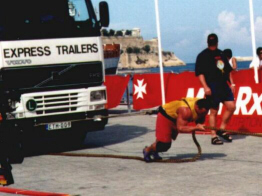
Always be careful not do overdo things. Succesful athletes
are often the ones who master the art of riding the fine line of
overtraining. The reason strongman training requires such a
great volume of work is simple. The sport requires the brute
strength of a powerlifter, the explosive, or speed strength, of a weightlifter
or thrower, the speed and conditioning of a football player, and
the muscular endurance of a freestyle wrestler. To be a good
strongman, you must be a good athlete, and you must constantly work on
eliminating any weaknesses.
Without getting into a deep discussion of the principles of periodization,
I do feel there are simple guidelines one should use when preparing
for a competition. The first priority of any pre-meet training
cycle should be getting in shape. Improving your conditioning early
on (i.e. 2-3 months before a meet) will not only help you perform better
on meet day, but it will also give you the ability to better handle
the workload to come later in the training cycle. At this time,
the individual's "core strength" should be worked on (or to put it
another way, working on the strength of "core lifts"), and special
attention must be paid to improving any weak areas (i.e. grip strength,
etc.). This is also the right time to get rid of any excess
bodyfat. While extra "dead" weight may help your leverage in
2 out of the 3 powerlifts, it doesn't have a place in the sport of
strongman. A couple of months or more before the meet, the
total training volume (the amount of work done) will be extremely high,
with only moderate intensity. It's simply impossible to train
at such a high level of intensity year-round. As the meet nears,
one's training must take on a more sports-specific approach.
This is where event training comes in.
In the weeks before a meet, events are gradually incorporated into the
training schedule and, at the same time, extra conditioning work is phased
out (more on this in the "Conditioning" section). In addition, the
volume of work drops and the level of intensity is raised.
The last 2-3 weeks should probably be nothing but event training.
Virtually all assistance work should be cut out so that you can concentrate
solely on the events to be found in the competition (this is assuming
you know the events ahead of time).
II. Event
Training
If you ask me, the sport of strongman is roughly 50% strength, 50%
skill. It's not always the strongest man that wins; more often, it's
the best prepared. Perhaps it shouldn't be this way, but it
is. This brings me to my point, that to be a succesful strongman,
you MUST train the specific
events. "Practice"
may actually be a better term, since many events are so technical
that mastering them is akin to learning any motor skill for the first
time. Don't believe me? Attend any competition where there
is a yoke walk (BTW...It's "Y-O-K-E," NOT "Y-O-L-K!"
I've never heard of an animal pulling a plow using one of those slimy
yellow things found in eggs! ;)
Anyway, a 1000lb. squatter will be fed a piece of "humble pie" by a 400lb.
squatter EVERY time provided that the latter has trained specifically for
the event and the latter has not. Becoming proficient at strongman
events requires that you build, or in some way acquire, the various
implements for yourself. This is no easy task, but I can assure you
it is well worth the
time, effort, and
money. Take Jouko Aholo and Phil Pfister, two of the most succesful
strongmen in the world today, for example. Both men have at their
disposal nearly every implement that could possibly show up at a
competition. In the very least, I would recommend that anyone serious
about the sport try to obtain the following implements: O2
cylinders or other farmer's walk apparatus, yoke, 2" rope (at least
50', preferably 100' in length) and harness for the arm-over-arm
and harness pull, 5-800+lb. tire, steel log, sled for the object
drag, and if possible, a set of spherical stones. The implements
listed should cover the vast majority of events to be found at any
strongman competitions. It is not my intention to turn into an article
on "implement construction." If you need advice on how to build
any of the various implements just e-mail me and I will gladly point you
in the right direction.
The question of how to fit event training into one's schedule inevitably
arises. The answer is perhaps best left up to the individual, as
no 2 people have the same body types, strengths, weaknesses, or perhaps
most importantly, recuperative abilities. One popular method
which works well for many is to spend 1 week in the gym, and the next week
on events, alternating back and forth. Personally, I find it
difficult to stay out of the gym for an entire week, so I mix my
gym training with event training.
Most of the time I will train the events in the evening after coming home
from the gym. Regardless of what schedule you choose, make event
training a top priority. Finally, make it a point to train
the evnts as heavy as possible. Try and use implements heavier
than those found in the competition. This will build confidence
and make the competition weights feel lighter than normal.
III. Gym Training
The first subject I want to touch on when talking gym training is the
bench press. I hate to disappoint you, but when it comes to the sport
of strongman, the bench press takes a backseat in importance to the
overhead lifts. The last (and only) time I can recall the World's
Strongest Man
competition having
an event which duplicated the mechanics of the flat bench press was
over 15 years ago in Sweden. The competitors were required to
press a giant log while lying on their backs (an American won, of course).
On the other hand, nearly every competition has at least one event which
tests overhead strength. I'm not suggesting you give up the bench
press altogether, but switching emphasis to the overhead lifts may
be a good idea (and your shoulders may thank you). I think
it's best to do a wide variety of overhead exercices: barbell and
dumbbells, seated and standing, in front and behind the neck (if flexibility
permits), strict, push press, and push jerk. When it comes
to conventional gym lifts, pressing is second only to the deadlift
in order of importance to the strongman. Some events like the
rock press test strict or pure pressing power, while the flinstone press
and others test explosive strength to a greater degree. It
is my experience that someone who is a good strict presses is not necessarily
good on the dynamic overhead lifts, and vice-versa. Usually,
I will do 1 strict and 1 explosive movement in each shoulder workout.
For instance, if I begin with seated behind-the-neck press, then
I may finish with some standing push jerks, done in front with a
medium grip. I find that 2 primary movements are enough, and
I will end by choosing 1 or 2 assistance exercises out of the following:
dumbbell press-seated or standing, done in a loose, rhythmic fashion,
usually for high (12-20) reps, plate raises, side laterals, and front
dumbbell raises. On a related note, it may be a good idea to do some
work on a steep incline, as the incline log press for reps shows up
frequently at competitions. If you don't have a log, use dumbbells.
Keep the palms facing each other, and use a fast rep tempo, exploding
off of the bottom. High reps (12-25) work well. This
exercise is different from a conventional barbell press, for it shifts
emphasis from the front delts onto the lats and triceps. Just
because you are not a world-class bench presses does not mean you
can't win the incline log event at you next contest.
Whenever time permits, I end my overhead workout with rear delt and rotator
cuff work. Strengthening these small muscles goes a long way towards
injury prevention, and you may be suprised to find that it adds to
your pressing strength.
Like the bench press, the squat also plays a fairly limited role in
strongman competitions. For some reason, maximum leg strength is
rarely tested. Squats still have their place, but they are
best done for relatively high reps and in an olympic style-high bar,
close stance, and rock bottom. Don't use any support
equipment (not even a belt if you can help it), and explode out of
the hole. Doing your squats for high reps (15-20+) will help
build both the leg endurance and mental toughness required by so
many events. Assistance movements like leg extensions and hamstring
curls are largely a waste of time. For hamstrings, I would stick
with stiff-leg deadlifts and glute-ham raises. If you don't have
access to a glute-ham machine give the following a try: kneel on
top of a bench with legs forming a 90 degree angle at the knee joint.
Next, have someone sit on the back of your calves, securing you to
the bench. Keeping an upright torso, slowly lean forward as
far as you can. Straighten yourself by contracting the glute
and hamstring muscles. If you are week at the movement (as
I am) have another person sit in front of you. Keep your hands
on their back and give yourself forced reps. This will also keep
you from falling all the way forward. Another great lower-body exercise
you can do is step-ups. I like to use dumbbells, but a barbell
will work as well. Choose a sturdy bench or step, at least 12" high,
and step one leg at a time. Many events (object drag, yoke,
etc.) require a great deal of localized muscular endurance in the
legs. Step-ups will help get your legs in the right kind of
shape.
For my next competition (provided there is no squat event), I plan on
eliminating squats altogether about 6-8 weeks out. I have recovery
problems with my lower back, finding my erectors can't handle the
combined stress placed on them by deadlifts, the yoke, farmers walk,
stones, AND squats. You may experience the same problem when you
begin training the events, so you must prioritize. Analyze
your training schedule, and give adequate spacing between workouts
which directly (or indirectly) target the lower back. While
some may suffer from dropping squats, I find that I get more than
enough leg work from the yoke, object drag, step-ups, etc..
For arms, you need to drop the bodybuilding/"foo-foo" movements and
stick with the basics. In our sport, the biceps play a much more
significant role than do the triceps. Arm-over-arm, the stones, log
lift, 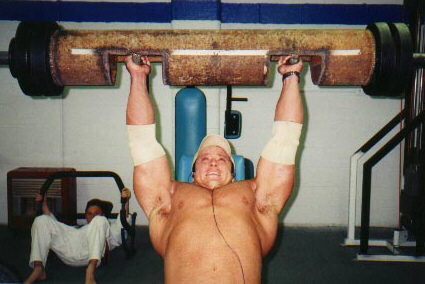 loading, and harness pull with rope all require very strong biceps.
Two of the most usefull movements are heavy barbell curls and hammer
curls. 3-4 work sets each on these 2 exercises should be plenty.
Don't be afraid of going heavy on your curls-as low as 3-5 reps.
Remember you are attempting to build strength, not just going for
the "pump."
loading, and harness pull with rope all require very strong biceps.
Two of the most usefull movements are heavy barbell curls and hammer
curls. 3-4 work sets each on these 2 exercises should be plenty.
Don't be afraid of going heavy on your curls-as low as 3-5 reps.
Remember you are attempting to build strength, not just going for
the "pump."
For back, do a wide variety of movements. Chins, T-bar rows, bent
rows, and an assortment of cable rows work well. I recommend doing
1 pulling movement on your back day. Doing pulling movements
will help build explosive power, a vital element of your success
as a strength athlete. I do 3-4 weeks of 1 exercise then switch
when the lift begins to plateau. I do power cleans, hang cleans,
high pulls, and what resembles a low/mid pull.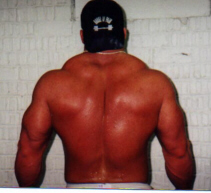
I don't do snatches because, well, I CAN'T do snatches-not very
well at least. Multiple sets of low reps work better than high-rep
sets on these movements. If you do any pulling movements, perform
them at the beginning of your workout when your body and nervous
system are fresh.
Other useful gym exercises to add to your strongman training arsenal
include zercher squats, zercher deadlifts, and heavy squat supports.
On the supports, unrack a weight well above your max squat and hold
it for time.
If you don't have any circular stones with which to practice, you can
roughly simulate the movement in the gym. Place a barbell on the
floor, loading 1 45lb. plate on one side and 3-4 45lb. plates on
the other side. Straddle the barbell, facing the heavy side.
Next, bend over and bear hug the plates, and try to break them off
the floor. Add weight each workout, and be sure to use a collar
to secure the plates on the barbell. The static lifts are other
examples of events which can be practiced in the gym. Both
the crucifix and forward hold show up frequently at competitions, so it
wouldn't hurt dedicating a little time to both. For the forward hold,
use a 45lb. barbell, adding weight if you can. For the crucifix,
a pair of dumbbells will suffice. Choose a weight you can hold
between 30 and 75 seconds. Any longer and the weight is too
light.a Any shorter and you are risking injury.
Heavy abdominal and oblique work is a must. A strong midsection is
necessary in many events, especially those where movement is involved.
The yoke walk, for example, requires that the abdominal and oblique
muscles work together to stabilize the body. If your midsection
is weak, you may notice these muscles becoming sore after practicing
this event. Like any other muscle group, the abdominals are
best strengthened by resistance exercise.
Weighted sit-ups, combined with heavy side bends, work exceptionally well.
If your dummbells don't go much heavier than 100lbs., try side bends with
a barbell placed in the power rack. Ultra high-rep sets will
give little results for the effort. If you are overly concerned
about developing a
thick or blocky waste
then you may want to consider changing sports (though in my opinion
such concerns are largely unwarranted).
IV.
Conditioning
Conditioning is perhaps the most overlooked and underrated facet of the
sport. To be competitive, you MUST be in shape. I learned my
lesson the hard way at the WSM in Malta. I was weighing only
225 when i received the invitation 5 weeks out. Because i was
trying to put on weight so quickly, I intentionally neglected any
conditioning work. There is no doubt in my mind that this cost
me making the finals (that and being too short ;). Most contests
are completed in a single day. This means the athlete may have
5 or 6 events to contend with in just as many hours. Adequate recovery
between events is a must, and this is facilitated by a well conditioned
body.
To take a page from Louie Simmon's book, I believe dragging weights
to be one of the most useful exercises a competitive strongman (or
strength athlete in general) can do. Dragging weights will
boost your squat and deadlift poundages over time by strengthening
you quads, hams, glutes, and hips. It will also raise your
work capacity. By getting in shape, you effectively increase
the total volume of work you can handle, as well as the amount of
work you do in a given amount of time. When dragging weights,
start slowly and work up. Currently, I drag 6-7 days a week (when
weather permits), using 100-200lbs. for anywhere from 1000-2000+
feet. I only drag 3 different ways: walking forward, backward,
and bent forward with the straps held between the legs (which works
wonders for the hamstrings). This is as fancy as I get.
As most strongman events are anaerobic in nature, one should perform
anaerobic/interval type training, rather than aerobic training, especially
as the latter can be counterproductive to strength gains (NO, I won't make
you suffer through another "sprinter vs. marathon runner" analogy).
Conventional wind sprints work well, as does alternating walking with
sprinting. You can also try running stairs with a light pair of dumbbells.
Heavier athletes may want to hit the bike or stairstepper to help save
their joints.
As mentioned in a previous section, extra conditioning work should be
eliminated as a meet approaches. Your body and nervous system will
have a hard enough time recovering without the added burden of conditioning
work.
In the final weeks, your event training will maintain (if not improve on)
any level of conditoning you have already acheived. In other words,
many of the events can/will serve as your conditioning work in themselves.
Some events which cause the lungs to scream in agony include the
yoke walk, tire flip, carry/push & drag, harness pull, loading,
and of course the farmers walk.
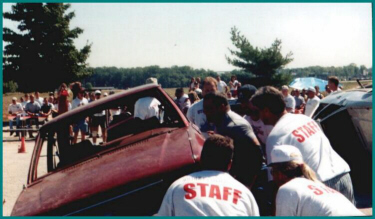 V. Odds &
Ends
V. Odds &
Ends
I would strongly recommend you keep a workout log, or journal, when
training. Excluding warmups, write down every set of every exercise
you do. This will give you something to look back on,
and something to guage your progress by. It doesn't matter
how good your memory is, it simply can't compare to written evidence
of workouts past. Keep a journal-you'll be glad you
did.
Keeping a set of running records has always played an integral role in
my training program. I find it helpful to keep records on every exercise,
as well as every event. The list of records Ii keep is almost endless:
log clean & press for max, 265lb. log clean and press in 90 seconds,
deadlift for max and for reps, deadlift in various rack heights,
dummbell shoulder press w/ 120's & 90's, strict curl, hammer
curl for reps, 275lb. incline log press for reps, squat reps at 495
& 585, crucifix, weighted dips, 265lb. military press for reps,
etc., etc. Believe me when i say the list goes on.
I have every single record in the back of my journal, and I try to break
a record every single workout. Keeping records not only helps you
keep track of improvements, it also serves as a great motivational
tool. It's easy to look forward to going to the gym when I
have a record I'm
attempting to break.
A final subject I want to discuss is grip training. The sport of
strongman requires that you be strong through every part of your body,
and we've all heard the old cliche "You're only as strong as your
weakest link."
For many athletes (myself included), this "link" happens to be the grip.
I don't pretend to be an expert on grip training, and there are many other
resources (some on the web) with valuable information (for a wide variety
of grip exercises, check out John Brookfield's "Mastery of Hand Strength).
I do however, have some basic advice I feel may be of some
benefit to you. First, you must realize that "crushing" grip strength
does not necessarily have a positive carryover to "supporting" grip
strength. Squeezing the grippers all day wil not turn you into
Chad Coy when it comes to the farmer's walk. It's really quite
simple, if you want to be good at the farmer's walk, then practice
the farmers walk. I've also found that the grip can be overtrained
just like any other bodypart, especially when trained heavily.
For most, 2-3 grip workouts a week seems to do the trick.
Some of the grip exercises I keep records of include 1 arm hangs from a
1" bar (bodyweight & with a dummbell in the other hand), 2 arm
barbell holds (held in a deadlift lockout position) with various
weights for time, 1 arm barbell holds to the side with 135, 185,
and 225lbs., 2" dummbell holds, and pinch grip for time. Experiment
to see which exercises work best for you.
When trying any grip exercise for the first time you may find that your
time and/or amount of weight used jumps considerably each workout
for the first 2 weeks or so.
I want to take this opportunity to voice my opposition to those who
suggest that one never use straps in order to develop their grip.
While not relying on straps with pulling and rowing exercises will
help develop your grip, you may be defeating the purpose. It's
only logical-if your strength on any given exercise exceeds your
ability to hold onto the bar, then you need to use straps.
If I never used straps on heavy shrugs, pulls, and partial deadlifts,
then my traps and spinal erectors would never be overloaded.
When I do deadlifts, I want to think about my back, NOT my grip.
My grip needs to be the last thing on my mind. I have "grip day"
to worry about/work on my grip.
Well, there you have it-my comments/observations on training for the
sport of strongman. If you have any questions or comments, feel free
to e-mail me . Best
of luck in your training and in any future competitions!!
|
|

|
Want to discuss this with other lifters?
|
Then click here:
|
|
Reproduction of this article, in whole or part,
for any purposed other than personal use is prohibited without written
consent. Copyright ©2000 Whit Baskin

|
|


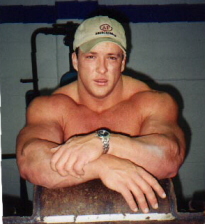


 loading, and harness pull with rope all require very strong biceps.
Two of the most usefull movements are heavy barbell curls and hammer
curls. 3-4 work sets each on these 2 exercises should be plenty.
Don't be afraid of going heavy on your curls-as low as 3-5 reps.
Remember you are attempting to build strength, not just going for
the "pump."
loading, and harness pull with rope all require very strong biceps.
Two of the most usefull movements are heavy barbell curls and hammer
curls. 3-4 work sets each on these 2 exercises should be plenty.
Don't be afraid of going heavy on your curls-as low as 3-5 reps.
Remember you are attempting to build strength, not just going for
the "pump."
